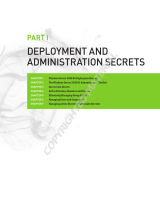
Contents
1 Overview........................................................................................................................................................5
iSCSI deployment...............................................................................................................................................................5
Dell supported hardware and software........................................................................................................................... 5
Preinstalled roles and services congurations on your system.................................................................................... 6
Roles and Role Services.............................................................................................................................................. 6
Features.........................................................................................................................................................................6
2 Initial conguration of your NAS system........................................................................................................ 8
Server Manager roles, role services, and features.........................................................................................................9
Starting and exiting Server Manager.........................................................................................................................9
Installing or uninstalling Server Manager roles, role services, and features................................................................9
Accessing administrative tools for your NAS system.................................................................................................... 9
Accessing computer management.................................................................................................................................. 9
System tools................................................................................................................................................................10
Storage.........................................................................................................................................................................10
Services and applications.......................................................................................................................................... 10
Work folders...................................................................................................................................................................... 10
Installing work folders.................................................................................................................................................10
Creating sync share for work folders........................................................................................................................ 11
Creating a new DFS namespace..................................................................................................................................... 11
Creating new DFS replication group...............................................................................................................................12
Adding DFS namespaces to display................................................................................................................................12
Adding replication groups to display............................................................................................................................... 12
File Server Resource Manager (FSRM)........................................................................................................................ 12
Multipath I/O (MPIO)...................................................................................................................................................... 13
Managing devices on MPIO...................................................................................................................................... 13
3 Managing your NAS system......................................................................................................................... 14
Dell OpenManage server administrator..........................................................................................................................14
Remote desktop for administration................................................................................................................................ 14
Activating remote desktop connection.................................................................................................................... 15
Creating and saving remote desktop connection................................................................................................... 15
Reinstalling NAS operating system by using DVD........................................................................................................ 15
Dell Rapid Appliance Self Recovery (RASR)................................................................................................................. 16
Creating RASR USB recovery drive......................................................................................................................... 16
Recovering OS using RASR USB Recovery Drive..................................................................................................16
4 Using your NAS system................................................................................................................................18
Creating server message block share............................................................................................................................ 18
Modifying message block shares....................................................................................................................................18
NFS share.......................................................................................................................................................................... 19
Windows 2012 or 2016 domain controller as identity mapping source...................................................................... 19
User name mapping server as identity mapping source.............................................................................................. 19
Contents
3




















